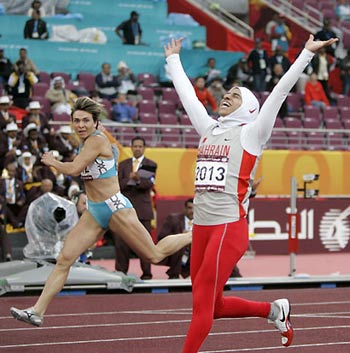Muslim athletes and their clothing
 For being on page A1 in The Washington Post, the article earlier this week on a high school athlete disqualified from a track meet for wearing clothing intended to be modest for religious reasons is missing a few things. Fortunately, we have the Internet, and the captions on the online photo gallery fill in a few details that were lacking from the story. The reporter is fairly sympathetic toward the talented athlete, and it is hard not to feel for the senior who is hardly gaining any competitive advantages by trying to adhere to the principles of her faith by wearing more clothing:
For being on page A1 in The Washington Post, the article earlier this week on a high school athlete disqualified from a track meet for wearing clothing intended to be modest for religious reasons is missing a few things. Fortunately, we have the Internet, and the captions on the online photo gallery fill in a few details that were lacking from the story. The reporter is fairly sympathetic toward the talented athlete, and it is hard not to feel for the senior who is hardly gaining any competitive advantages by trying to adhere to the principles of her faith by wearing more clothing:
Juashaunna Kelly, a Theodore Roosevelt High School senior who has the fastest mile and two-mile times of any girls' runner in the District this winter, was disqualified from Saturday's Montgomery Invitational indoor track and field meet after officials said her Muslim clothing violated national competition rules.
Kelly was wearing the same uniform she has worn for the past three seasons while running for Theodore Roosevelt's cross-country and track teams: a custom-made, one-piece blue and orange unitard that covers her head, arms, torso and legs. On top of the unitard, Kelly wore the same orange and blue T-shirt and shorts as her teammates.
The outfit allows her to compete while complying with her Muslim faith, which forbids displaying any skin other than her face and hands.
A friend of mine who has successfully competed in USATF, NCAA, and IHSAA track and field events and has spent time as a high school and college track coach told me that standards such as these for uniforms are necessary to keep "all things equal" on the track. That said, there is certainly no advantage to wearing extra clothing. The fact that she went to such great lengths to have the uniform custom made to conform to her school colors shows that she wasn't trying to cause any type of scene, or to stand out in any particular way.
Unfortunately, the story relies only on the director of the track meet to explain why Kelly was disqualified. The reporter could have looked to the people who make the rules and not just the person enforcing them. A simple reason that if Kelly is given special treatment, other kids who want to wear cross necklaces and other religious paraphernalia would expect similar treatment. The question that should be asked then is whether or not an exception to this rule should be created for athletes with religious objections such as Kelly.
Religious beliefs and sports have made for great stories that are worth careful exploration. Anybody remember the movie Chariots of Fire?
Not only does Kelly wear this special uniform, she does not eat or drink during the five-hour long track meets during the month of Ramadan, while those she competes against are able to eat what they need to keep their energy up for 3-plus mile long races. For some reason, the story neglects to mention this, but it comes up in the photo gallery captions:
Cross-country meets can last five hours or more, although the races themselves take approximately 25 minutes or less. To stave off dehydration before and after exhausting five-kilometer (roughly 3.1 miles) races, athletes usually chug water and sports drinks by the liter and devour granola bars, bananas and cookies. For Kelly, that would be a betrayal.
The Post will likely follow up on this story, and hopefully they can dig into whether or not it would be fair to grant Kelly and other athletes like her an exception for their religious beliefs and practices.
A great reference piece on this topic is this article Women's Sports Foundation Web site. The article raises a great point by pointing out that not all Muslim female athletes have the same religious standards for what they wear. While fundamentalists condemn successful athletes for wearing shorts in front of men, others compete in the Olympics without wearing the hijab. Speaking of the Olympics, hopefully reporters will pick up on this story this summer because it is bound to be an issue.